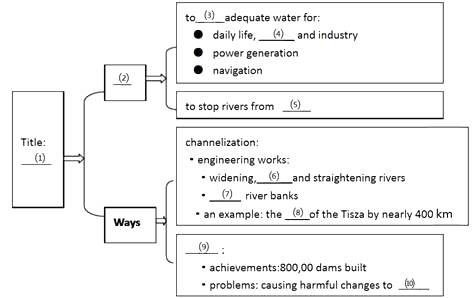Directions: Read the following passage. Fill in the numbered blanks by using the information from the passage.
Write NO MORE THAN THREE WORDS for each answer.
Since the earliest civilizations, people have controlled rivers to meet society's demands. Today, rivers are controlled for many reasons, primarily to maintain reliable water supplies for daily, agricultural and industrial needs, for power generation, for navigation (航行), and to prevent flooding.
River control is achieved by channelization, a term that covers a range of river engineering works, including widening, deepening, straightening and stabilization of banks, and by the construction of dams.
An important period of channelization took place in Europe during the l9'th century, when many large rivers were straightened and their beds deepened. One of the most dramatically changed was the Tisza River, a branch of the Danube that flows through Hungary. The controlling of the Tisza, designed to reduce flooding and make land for agriculture, included cutting off more than 100 meanders (河曲), shortening the river's length by nearly 400 kilometers.
One of the most common ways in which people control rivers is by damming them. The past 50 years or so has seen an increase in dam construction worldwide, and at the beginning of the 21st century, there were about 800,000 dams globally, some towering more than 200 meters in height.
Despite their successes, many dams also cause significant environmental changes that prove harmful. Some particularly deep reservoirs (水库) can bring about earthquakes due to the stress on their bottom rocks caused by huge volumes of water. Downstream of a reservoir, the river is certainly influenced in many ways: water volume, speed and quality are all affected, leading to changes in the landscape and among plants and animals.

⑴ ⑵ ⑶ ⑷ ⑸ ⑹ ⑺ ⑻ ⑼ ⑽